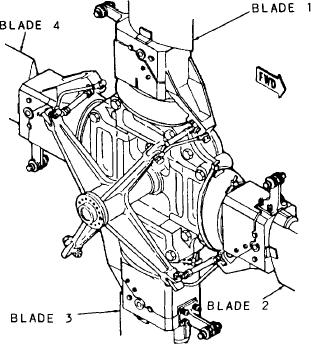
ROTOR SYSTEM MAINTENANCE
Organizational maintenance of the helicopter
rotor system includes periodic inspection, lubrica-
tion, rigging, and adjustment. Organization
maintenance includes the cleaning of the rotary
wing and rudder blades, and the removal and
replacement of malfunctioning components.
Vibration of the rotary mechanisms can result
in work hardening of metals and later fatigue
failure. Nondestructive testing of special parts of
the rotary wing and the rotary rudder at specified
intervals is necessary to prevent failures. The
rotary wing head and rotary rudder assemblies are
high-time removal items, as listed in the periodic
maintenance information cards (PMIC).
Cleaning of the rotary wing and rotary rudder
should be accomplished as necessary, using
approved cleaners mixed with water. The concen-
Figure 7-20.-Rotary rudder head.
tration of the mixture will vary, depending on the
surface condition.
is necessary when the blades, the main gearbox,
or the main rotor head assembly have been
WARNING
replaced. Unless the blades are in proper track,
vibrations will occur in the helicopter with every
Both the rotary wing and rudder blades
revolution of the main rotor. At high rpm settings,
have areas that are joined by bonding
these vibrations could cause serious structural
adhesives. Never use solvents or cleaners
damage.
not specifically authorized in the MIM.
Never use lacquer thinner, naphtha, carbon
Tracking the blades is necessary to be sure that
tetrachloride, or other organic compounds
all of the blades rotate in the same horizontal
for cleaning in these bonded areas. The
plane (track). This is accomplished by pretrack
bonding will be weakened by the solvent
rigging of the rotary wing head and by the use
and may result in blade failure.
of pretracked blades.
Although ADs remove and replace rotary
Pretrack rigging of the rotary wing head
wing parts, the airframes work center normally
involves adjusting the pitch control rods until
performs the rigging checks. Rigging checks and
an exact sleeve angle (within 1 minute) is
adjustment involve coordinating the cyclic pitch
attained on all sleeve spindles. When this exact
control stick, collective pitch control stick, and
angle is established, a micrometer type decal
pedal positions with the correct rotary wing and
is affixed on the adjustable pitch control
rotary rudder blade angles. Rigging checks are
rods. The decal becomes a permanent reference
necessary to ensure that the flight controls are
at the overhaul activity. A pretrack number
operating under normal friction loads. At the
is stenciled on each blade at manufacture or
completion of rigging, a flight test is performed
overhaul, based on the effective angle of the
by a qualified pilot. This includes a check of blade
blade. Install any pretracked blade on the
tracking.
helicopter simply by setting the adjustable
pitch control rod to the pretrack number stenciled
ROTOR BLADE TRACKING
on the blade. The blade tracking is then checked
with either Strobex or electronic tracking equip-
You should perform blade tracking whenever
ment.
the helicopter has been rerigged. Blade tracking
7-23

